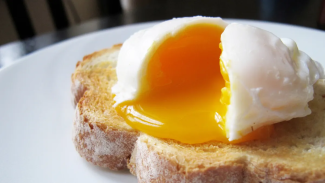Microwave Poached Eggs

Why I Love Microwave Poached Eggs
Poaching a single egg in the microwave offers two key advantages:
1.) It’s faster than boiling water on the stove.
2.) It results in just a single cup to clean up afterwards.
In my opinion, it’s easier than poaching via stovetop. Those scraggly egg whites are contained and there’s no need to hover.
And because of that, it encourages me to poach an egg more often. Lyonnaise salad, corned beef hash, eggs Benedict (a good excuse to make our blender Hollandaise) . . . when you have great-quality eggs, poaching takes full advantage.
The ideal poached egg has a flowing, runny yolk that should spill out when it's broken into with a fork, and the whites should remain set and thoroughly encapsulate the yolk. Aesthetically, the whites should look neat and nicely bound, not ragged and torn. But that’s mostly for breakfast Instagram posts, not because it impacts the flavor.
Since learning how to poach eggs in the microwave, I’ve stopped needing to haul out a large skillet to make a poached egg when Cooking for One. And that means more delicious eggs—not just for breakfast.
This method hasn’t failed me yet—but resist the urge to fuss with it too much. I tried cutting the time even further by adding boiling water from my electric kettle to the measuring cup; the egg didn’t set fully in 4 minutes. I suspect this is because not microwaving the cup itself means that the glass doesn’t get hot enough to continue insulating the water and egg once they’re at room temperature.
1½ cups of water
2 teaspoons of distilled white vinegar
¼ teaspoon of table salt
1.) Fill a glass measuring cup with 1½ cups of water, 2 teaspoons of distilled white vinegar, and ¼ teaspoon of table salt.
2.) Microwave the mixture on high until it reaches a rolling boil. In my (admittedly older-model) microwave, this took a little more than 5 minutes.
3.) Remove the cup from the microwave and use a spoon to slowly stir the water in a circular motion. Gently crack an egg into the liquid and give it one more slow stir.
4.) Cover the cup with plastic wrap and let it stand for 4 minutes. Remove the egg with a slotted spoon; let the water drip off; and voilà.
None Available.